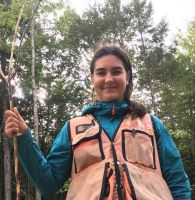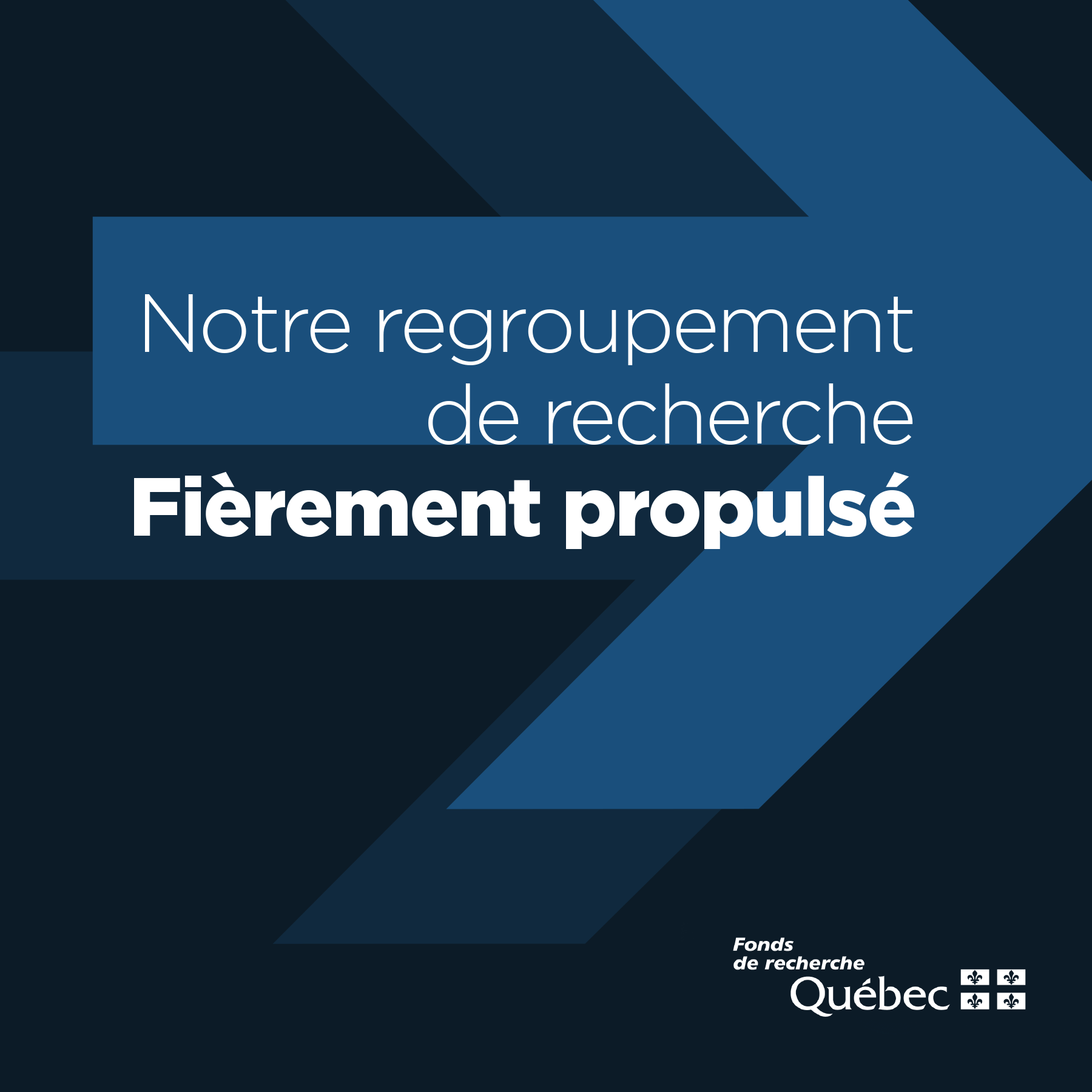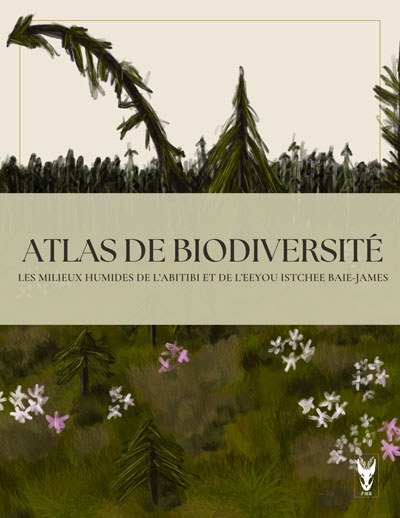
Élise Filotas
Chercheuse régulière
Complexité écologique et modélisation
Département Science et Technologie
TÉLUQ, Université du Québec
5800 rue Saint-Denis
Bureau 1105
Montréal, Qc, H2S 3L5
Page départementale ![]() | Site personnel
| Site personnel ![]() | ResearchGate
| ResearchGate ![]() | Google Scholar
| Google Scholar ![]() | Twitter
| Twitter ![]()
FORMATION
- Ph.D. Géographie, 2009 (Université de Montréal)
- M.Sc. Physique, 2002 (Université McGill)
- B.Sc. Mathématiques-physique, 2000 (Université de Montréal)
THÈMES DE RECHERCHE
Je m’intéresse à l’application des concepts et des modèles de la science des systèmes complexes à l’étude des écosystèmes forestiers sur de multiples échelles. Mes activités de recherche sont interdisciplinaires et visent à développer des outils de modélisation et d’analyse quantitatifs, théoriques ou appliqués, pour étudier deux thèmes principaux :
- La dynamique des communautés écologiques sur les paysages forestiers.
Comment les interactions inter- et intra-spécifiques entre les individus, et leur habilité à se disperser, influencent la dynamique de leur population à différentes échelles temporelles et spatiales? - La relation entre l’aménagement des forêts et leurs fonctions écologiques.
Comment les interactions entre les processus écologiques et l’aménagement influencent la dynamique et les fonctions des écosystèmes forestiers?
Vous pouvez télécharger toutes mes références bibliographiques en format BibTeX, BibTeX-CSV, FRQNT ou EndNote
PUBLICATIONS
Livres
Aucun
Chapitres de livre
- Filotas, E., Witte, I., Aquilue, N., Brimacombe, C., Drapeau, P., Keeton, W.S., Kneeshaw, D.D., Messier, C., Fortin, M.-J. (2023) Network Framework for Forest Ecology and Management. In Boreal Forests in the Face of Climate Change: Sustainable Management. (Montoro Girona, M., Morin, H., Gauthier, S. and Bergeron, Y., Eds.) Cham, Springer International Publishing, pages 685-717
- Pappas, C., Belanger, N., Bergeron, Y., Blarquez, O., Chen, H.Y.H., Comeau, P.G., De Grandpre, L., Delagrange, S., DesRochers, A., Diochon, A. et al. (2022) Smartforests Canada: A Network of Monitoring Plots for Forest Management Under Environmental Change. In Climate-Smart Forestry in Mountain Regions. (Tognetti, Roberto, Smith, Melanie and Panzacchi, Pietro, Eds.) Cham, Springer International Publishing, pages 521-543
- Messier, C., Carpentier, S, Angers, V.-A., Tittler, R., St-Denis, A., Handa, I.T., Filotas, E., Paquette, A. (2015) La véritable valeur des arbres et bois urbains et péri-urbains. In L’économie de la biodiversité et des services produits par les écosystèmes: Un regard sur les concepts, outils et sur l’état de l’avancement de la recherche au Québec. (Revéret J-P and Dupras J, Eds.) Presses de l’Université du Québec
Livres, numéros spéciaux et actes de colloques publiés à titre d'éditeur
Aucun
Articles révisés par un comité de lecture
- Hardy, C., Messier, C., Boulanger, Y., Cyr, D., Filotas, E. (2025) Climate is stronger than you think: Exploring functional planting and TRIAD zoning for increased forest resilience to extreme disturbances. PLOS ONE, 20(6):1-26
- McNie, P., Kneeshaw, D.D., Filotas, E. (2024) Increased unpredictability in spruce budworm outbreaks following habitat loss and landscape fragmentation. Ecological Modelling, 491
- McNie, P., Kneeshaw, D.D., Filotas, E. (2023) Landscape-scale patterns of eastern spruce budworm outbreak risk: Defoliation onset vs. tree mortality. Ecosphere, 14(11):e4684
- Bouchard, M., Aquilue, N., Filotas, E., Boucher, J., Parisien, M.-A. (2023) Forecasting wildfire-induced declines in potential forest harvest levels across Québec. Canadian Journal of Forest Research, 53(2):119 – 132
- Rademacher, T., Cliche, M., Bouchard, E., Kurokawa, S.Y.S., Rapp, J., Deslauriers, A., Messier, C., Rossi, S., Dupras, J., Filotas, E. et al. (2023) TAMM review: On the importance of tap and tree characteristics in maple sugaring. Forest Ecology and Management, 535:120896
- Hardy, C., Messier, C., Valeria, O., Filotas, E. (2023) A LANDIS-II extension for simulating forest road networks. Canadian Journal of Forest Research, 53(7):503 – 518
- Hardy, C., Messier, C., Boulanger, Y., Cyr, D., Filotas, E. (2023) Land sparing and sharing patterns in forestry: exploring even-aged and uneven-aged management at the landscape scale. Landscape Ecology, 38(11):2815 – 2838
- Loreau, M., Barbier, M., Filotas, E., Gravel, D., Isbell, F., Miller, S.J., Montoya, J.M., Wang, S., Aussenac, R., Germain, R. et al. (2021) Biodiversity as insurance: from concept to measurement and application. Biological Reviews, 96(5):2333-2354
- Levesque, A., Belanger, N., Poder, T.G., Filotas, E., Dupras, J. (2020) From white to green gold: Digging into public expectations and preferences for ecological restoration of asbestos mines in southeastern Quebec, Canada. The Extractive Industries and Society, 7(4):1411 - 1423
- Gonzalez, A., Germain, R.M., Srivastava, D.S., Filotas, E., Dee, L.E., Gravel, D., Thompson, P.L., Isbell, F., Wang, S., Kéfi, S. et al. (2020) Scaling-up biodiversity-ecosystem functioning research. Ecology Letters, 23(4):757-776
- Aquilué, N., Filotas, E., Craven, D., Fortin, M.-J., Brotons, L., Messier, C. (2020) Evaluating forest resilience to global threats using functional response traits and network properties. Ecological Applications, 30(5)
- Laginha Pinto Correia, D., Bouchard, M., Filotas, E., Raulier, F. (2019) Disentangling the effect of drought on stand mortality and productivity in northern temperate and boreal forests. Journal of Applied Ecology, 56(3):758-768
- Mayrand, P., Filotas, E., Wittische, J., James, P.M.A. (2019) The role of dispersal, selection, and timing of sampling on the false discovery rate of loci under selection during geographic range expansion. Genome, 62(11):715-727
- Laginha Pinto Correia, D., Raulier, F., Bouchard, M., Filotas, E. (2018) Response diversity, functional redundancy, and post-logging productivity in northern temperate and boreal forests. Ecological Applications, 28(5):1282-1291
- Laginha Pinto Correia, D., Raulier, F., Filotas, E., Bouchard, M. (2017) Stand height and cover type complement forest age structure as a biodiversity indicator in boreal and northern temperate forest management. Ecological Indicators, 72:288 - 296
- Nenzen, H.K., Filotas, E., Peres-Neto, P., Gravel, D. (2017) Epidemiological landscape models reproduce cyclic insect outbreaks. Ecological Complexity, 31:78 - 87
- Carpentier, S., Filotas, E., Handa, I.T., Messier, C. (2017) Trade-offs between timber production, carbon stocking and habitat quality when managing woodlots for multiple ecosystem services. Environmental Conservation, 44(1):14-23
- Messier, C., Puettmann, K., Filotas, E., Coates, D.K. (2016) Dealing with Non-linearity and Uncertainty in Forest Management. Current Forestry Reports, 2(2):150-161
- Craven, D., Filotas, E., Angers, V.-A., Messier, C. (2016) Evaluating resilience of tree communities in fragmented landscapes: linking functional response diversity with landscape connectivity. Diversity and Distributions, 22(5):505-518
- Messier, C., Puettmann, K., Chazdon, R., Andersson, K.P., Angers, V.-A., Brotons, L., Filotas, E., Tittler, R., Parrott, L., Levin, S.A. (2015) From Management to Stewardship: Viewing Forests As Complex Adaptive Systems in an Uncertain World. Conservation Letters, 8(5):368-377
- Tittler, R., Filotas, E., Kroese, J., Messier, C. (2015) Maximizing Conservation and Production with Intensive Forest Management: It's All About Location. Environmental Management, 56(5):1104-1117
- Filotas, E., Parrott, L., Burton, P.J., Chazdon, R.L., Coates, D.K., Coll, L., Haeussler, S., Martin, K., Nocentini, S., Puettmann, K.J. et al. (2014) Viewing forests through the lens of complex systems science. Ecosphere, 5(1):art1-
- Filotas, E., Grant, M., Parrott, L., Rikvold, P.A. (2010) The effect of positive interactions on community structure in a multi-species metacommunity model along an environmental gradient. Ecological Modelling, 221(6):885-894
- Filotas, E., Grant, M., Parrott, L., Rikvold, P.A. (2010) Positive interactions and the emergence of community structure in metacommunities. Journal of Theoretical Biology, 266(3):419-429
- Chisholm, R.A., Filotas, E. (2009) Critical slowing down as an indicator of transitions in two-species models. Journal of Theoretical Biology, 257(1):142-149
- Filotas, E., Grant, M., Parrott, L., Rikvold, P.A. (2008) Community-driven dispersal in an individual-based predator-prey model. Ecological Complexity, 5(3):238-251
- Burgess, C.P., Filotas, E., Klein, M., Quevedo, F. (2003) Low-energy brane-world effective actions and partial supersymmetry breaking. Journal of High Energy Physics, 7(10):1003-1029
- Burgess, C.P., Cline, J.M., Filotas, E., Matias, J., Moore, G.D. (2002) Loop-generated bounds on changes to the graviton dispersion relation. Journal of High Energy Physics, 6(3):1033-1066
- Atwood, D., Burgess, C.P., Filotas, E., Leblond, F., London, D., Maksymyk, I. (2001) Supersymmetric large extra dimensions are small and/or numerous. Physical Review D, 63(2):025007
Articles publiés dans des actes de colloque (proceedings)
- Rikvold, P.A., Filotas, E., Grant, M., Parrott, L. (2011) Mutualistic Interactions and Community Structure in Biological Metacommunities. In APS Meeting Abstracts. Page 44014
Rapports scientifiques, manuels et autres
- Tittler, R., James, P.M.A., Filotas, E. (2016) Faciliter l'intégration des principes d'aménagement multiservice des programmes de certification. Technical report, Resolute Forest Products
- Craven D., Angers, V.-A., Filotas, E., Tittler, R., Desrochers, M., James, P.M.A., Messier, C. (2013) L'aménagement écosystémique de forêts privées du Centre-du-Québec dans le contexte des changements globaux. Technical report, Agence Forestière des Bois-Francs
Thèses, mémoires et essais
- Filotas, E. (2009) Structure et dynamique des communautés multi-espèces : le rôle de l’espace. Thèse de doctorat, Université de Montréal
- Filotas, E. (2002) Partial supersymmetry breaking in brane-world scenarios. Mémoire de maîtrise, Université McGill
Thèses, mémoires et essais supervisés
- McNie, P. (2024) A landscape level analysis of factors affecting current and future outbreaks of the spruce budworm Choristoneura fumiferana. Thèse de doctorat, Université du Québec à Montréal
- Gagne, C. (2023) Analyse spatiotemporelle d’un territoire agroforestier : quand les conditions paysagères du passé et du présent s’unissent pour influencer les communautés forestières. Thèse de doctorat, UQAM
- Laginha Pinto Correia, D. (2018) Potentiel d'utilisation de la diversité fonctionnelle des arbres dans l'aménagement durable des forêts tempérées nordiques et boréales. Thèse de doctorat, Université Laval
- Carpentier, S. (2015) Services écologiques et aménagement forestier-vers une nouvelle approche en forêt privée du sud du Québec. Mémoire de maîtrise, Université du Québec à Montréal
Articles non révisés par un comité de lecture
Aucun
<< Nicole Fenton | MembresReguliers | Daniel Fortin >>










